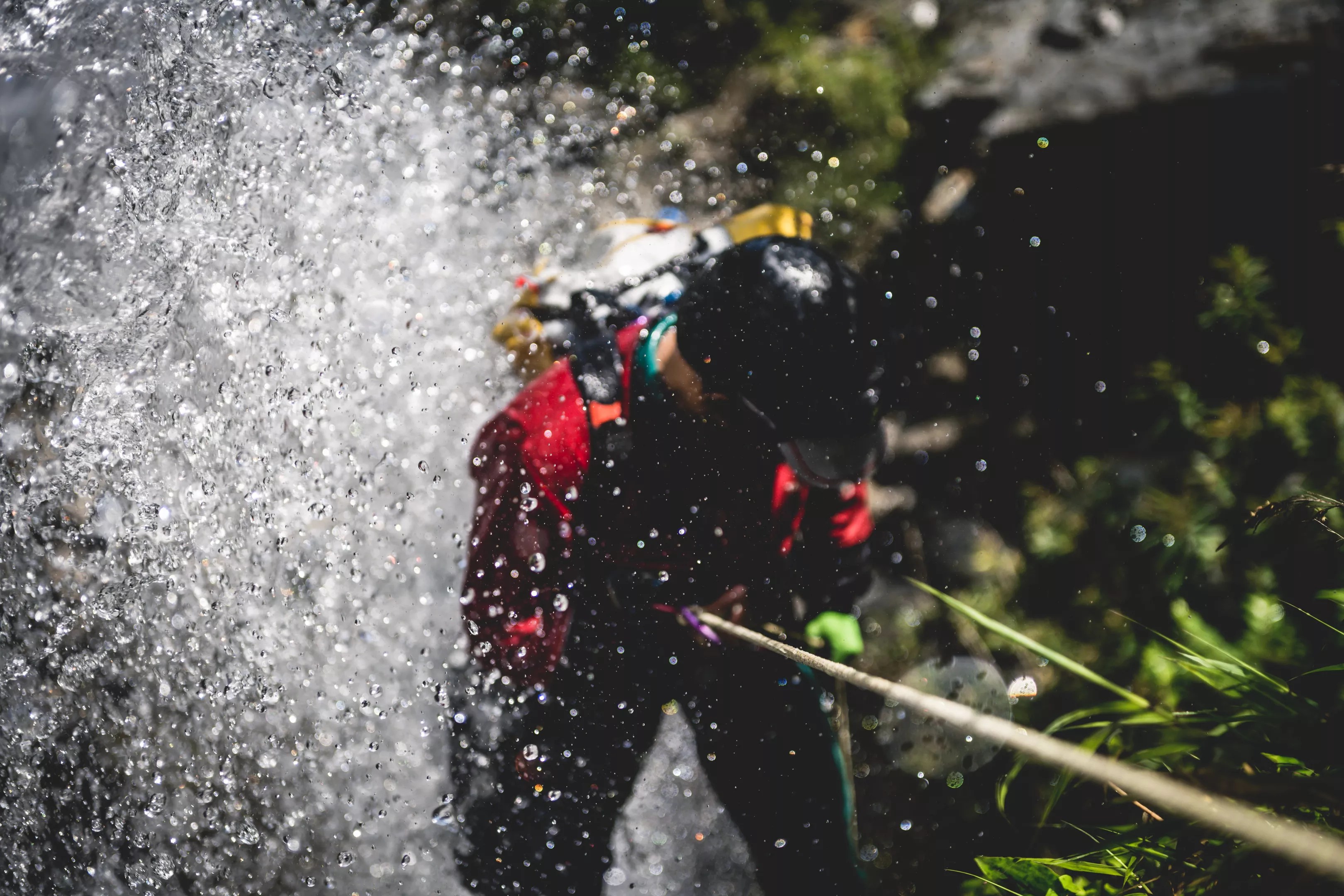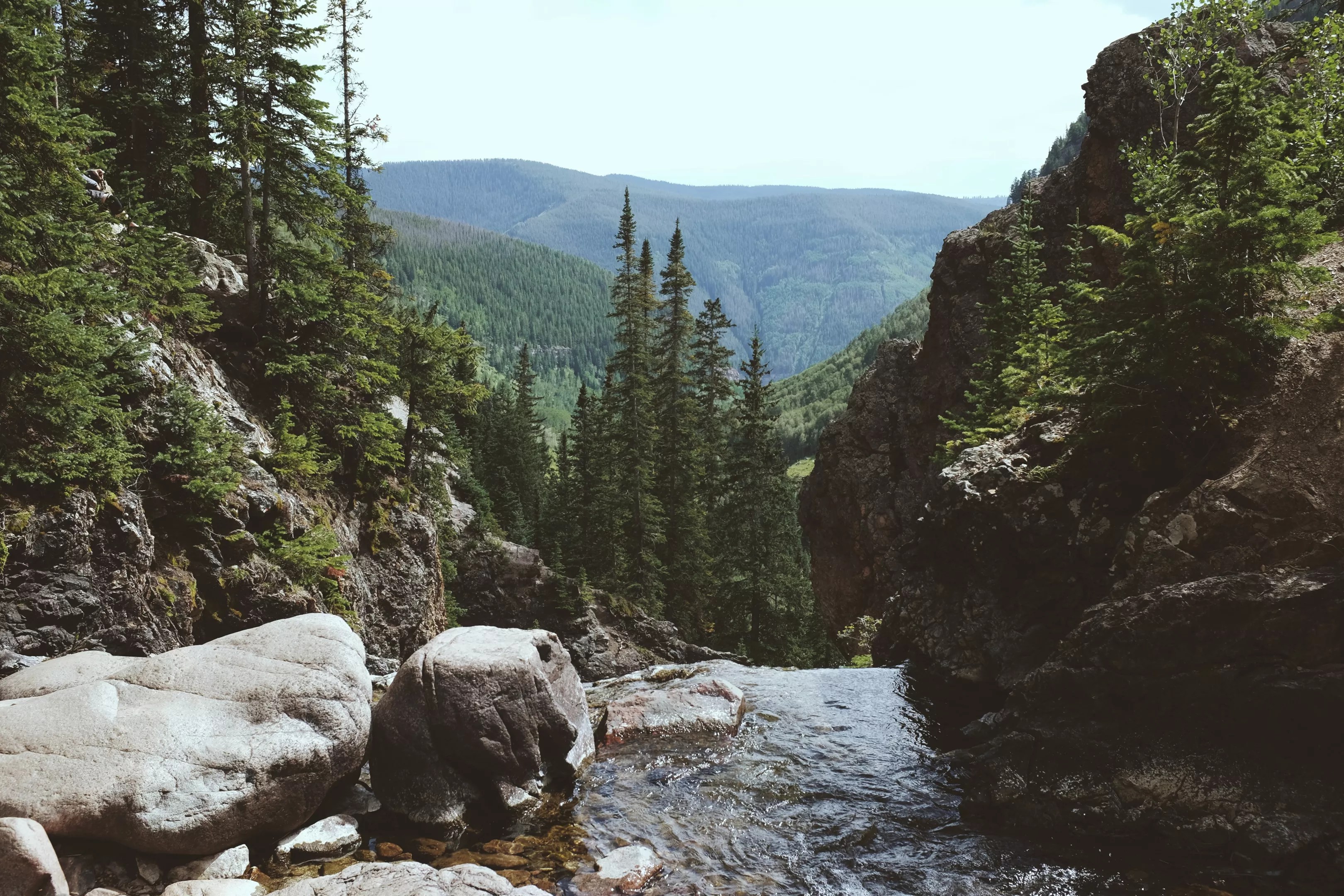
Unsplash/Han-Hsing Tu

Audio By Carbonatix
Although growing in popularity, canyoning remains a niche sport largely because of its regional limitations. Most of these skilled adventurers head to Utah, a prime destination famed for skinny slots, big raps and redstone scenery. On the other hand, most canyons in Colorado are known for their splashy, cold descents through pools and waterfalls. It’s not the easiest place to learn the sport, which comes with risks and requires a variety of skills.
Mastering the basics of climbing is a good first step, as it and canyoning share many of the same disciplines, such as balance, knot techniques and method to grip various holds. If you practice climbing up technical routes, you’ll be better prepared for downclimbing in canyons. The same goes for rappelling, the term used for descending down a rock face.
Local climbing gyms allow you to home in on many of these abilities, but nothing quite compares to being in an actual canyon. Before embarking on your own trip, take a guided tour, understand difficulty ratings and get very familiar with the beta – or route description – of your first canyon. For those prepared for the challenge, check out these ten thrilling places to go canyoning in Colorado:
Angel Creek
Ouray
A technical canyon suited for beginners, Angel Creek is found at lower elevations in Ouray. It’s generally accessible from May through September and is one of few canyons in the San Juan Mountains that doesn’t require a wetsuit. However, as in all Ouray canyons, expect to get drenched, especially on the first rappel. This route is rated 3C1, with four raps maxing at 35 feet. Get your feet wet by booking a tour with Canyoning Colorado.
Denver, make your New Year’s Resolution Count!
We’re $10,000 away from reaching our $50,000 year-end fundraising goal. Your support could be what pushes us over the top. If our work has kept you informed and connected this year, please consider making a contribution today.
Purple People Eater Canyon
Crested Butte
Tucked away in the Gunnison National Forest, Purple People Eater Canyon is loved for its unique features and back-to-back rappels. Carl Marvin and Eric Klammer completed this first descent in 2019, paragliding to the start of the 3C2 canyon. Those without such know-how approach this route by crossing the Slate River and hiking up to the large bench. Here you’ll find seven rappels, the largest two measuring 170 feet. Once at the bottom falls, a series of downclimbs leads into incredible ice caves that have been explored by very few.
East Inlet Narrows
Grand Lake
Experiencing the East Inlet Narrows requires a national parks pass, timed entry permit and some serious canyoning skills. This 3C3 route in Rocky Mountain National Park features five raps down fast-moving waterfalls, reaching a max of 80 feet. Beginning at the East Inlet Trailhead, you’ll also pass an overlook of Adams Falls, one of the best waterfalls near Denver. If technical canyons aren’t your thing, take the easy 0.8-mile trail there, or explore one of the other best hikes in Rocky Mountain National Park.
Bear Creek
Ouray
Tight canyons are less commonly seen in Colorado, but Bear Creek includes some narrow sections that are stunningly beautiful. Towering walls and rock formations amaze, and in the “quartzite corridor,” canyoners downclimb and swim their way through the thin passageway. The biggest of the six raps extends 100 feet, and the trip lasts as long as nine hours. Though demanding, this route can be completed by those with intermediate skills. Guided tours are also available.
Buckwater Draw
Dinosaur
Canyoners accustomed to terrain found in places such as Utah and Arizona will appreciate Buckwater Draw. The South Fork slot canyon mirrors many of those found in the Robbers Roost and Escalante regions, and is one of few Colorado canyons without significant water exposure. However, given the fact that this canyon is taller than it is wide, flash flood risks exist. Always check weather predictions before descending your first rappel!

Beautiful views of Booth Creek near Vail, Colorado.
Unsplash/Kaitlin Muro
Booth Creek
Vail
This 3C2 canyon in the Eagles Nest Wilderness makes for a great day trip from Denver, but is reserved for experienced canyoners. Although the water here is cold and often extreme, the route is short, with less than a half-mile descent. The approach leads canyoners up a scenic aspen forest, then through the rocky Upper Gorge. Two epic rappels down the iconic Booth Falls follow – both more than 100 feet and surrounded by natural beauty.
Wolf Creek
Pagosa Springs
Many who enjoy hiking in Colorado often hear these words of caution: “Start early to avoid afternoon storms.” But when it comes to canyoning, you might receive the opposite advice. The rushing waters of Wolf Creek are very, very cold. It’s advised to start your descent no earlier than 11 a.m. so that you’ll receive some sun exposure while in the canyon. In total, the Upper and Lower sections include sixteen rappels as tall as 115 feet. For an intermediate experience, take on just the Lower route (six raps, max 70 feet) during low water, often present in September.
Beaver Creek
Cañon City
No, not that Beaver Creek. This one isn’t a swanky resort, but rather a popular fishing destination for trout as well as those looking for a rugged but easy jaunt punctuated by small waterfalls and intermittent narrows (meaning the cliff walls are sometimes much closer together) in the shadow of Pikes Peak. Located just 23 miles northeast of Cañon City, the well-marked trails through this granite-lined canyon include a 5-mile out-and-back and a 5-mile loop trek. The trailhead is located in the Beaver Creek State Wildlife Area, which means keep your eyes peeled for the massive herd of bighorn sheep that calls this gorgeous spot home, along with the namesake beavers and a few elk, deer and black bears. Note that in spring and times of heavy rainfall, the robust year-round creek that gives the canyon its name can look more like a river.
Arapaho Creek
Rollinsville
Arapaho Creek may not be the most celebrated canyon on this list, but its location on the Front Range makes it easily accessible from Denver. The approach begins from the East Portal of the Moffat Tunnel, gaining nearly 500 feet across the span of a mile. Here, trees serve as natural anchors, allowing canyoners to descend each of the three picturesque waterfalls.
Lime Creek
Durango
Located near Purgatory Resort, Lime Creek begins with a downward approach, dropping nearly 800 feet in elevation. On this 3C3 route, canyoners will want to bring ropes and other technical gear for safety reasons. But with deep pools, all rappels can actually be done by jumping or splashing down wet, slippery rocks, also known as tobogganing. Swift-water experience is important during July’s high conditions, but like all Colorado canyons, Lime Creek generally mellows later in the season.